Page 604 of 668
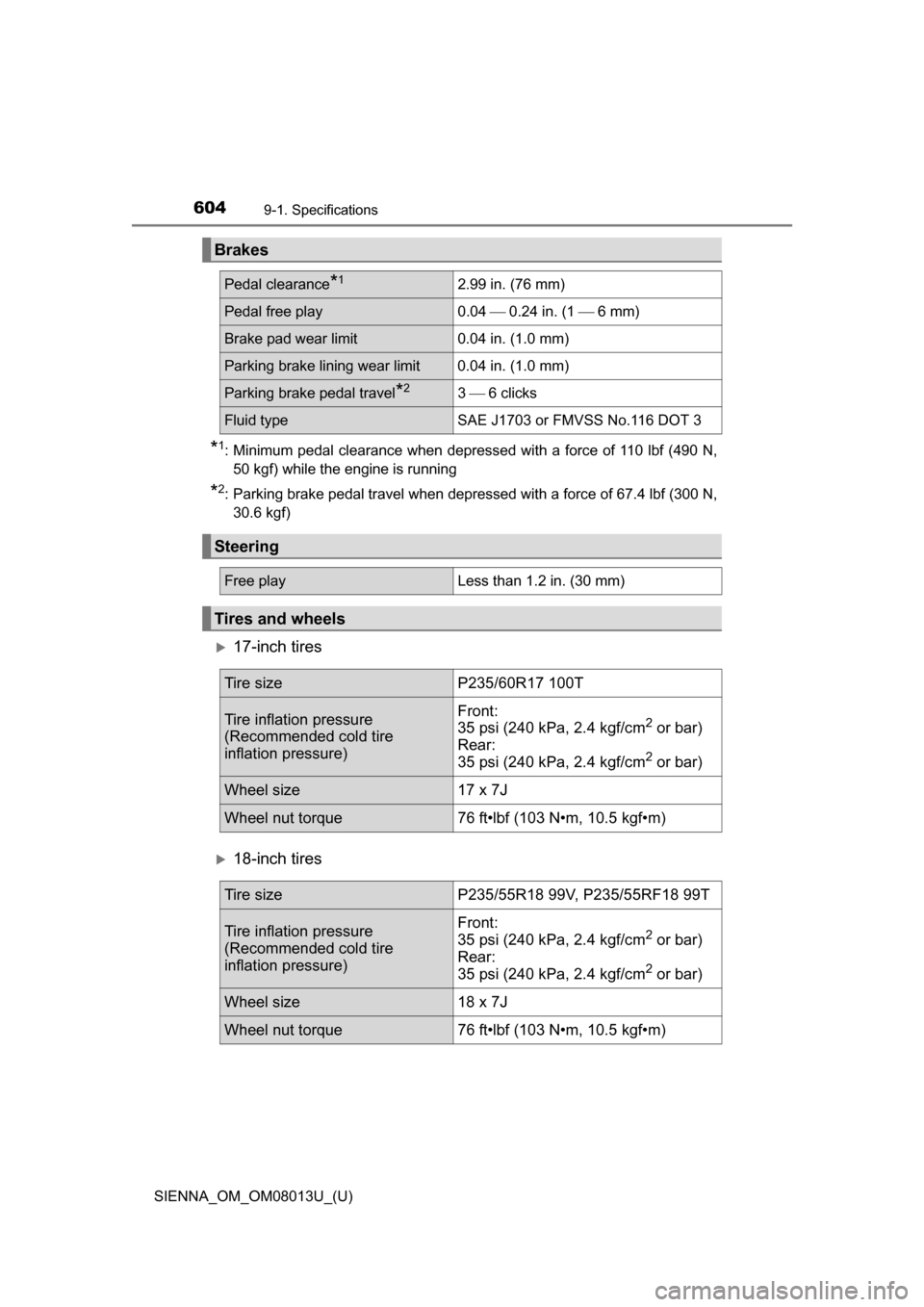
604
SIENNA_OM_OM08013U_(U)
9-1. Specifications
*1: Minimum pedal clearance when depressed with a force of 110 lbf (490 N,50 kgf) while the engine is running
*2: Parking brake pedal travel when depressed with a force of 67.4 lbf (300 N,30.6 kgf)
17-inch tires
18-inch tires
Brakes
Pedal clearance*12.99 in. (76 mm)
Pedal free play 0.04 0.24 in. (1 6 mm)
Brake pad wear limit0.04 in. (1.0 mm)
Parking brake lining wear limit 0.04 in. (1.0 mm)
Parking brake pedal travel*23 6 clicks
Fluid type SAE J1703 or FMVSS No.116 DOT 3
Steering
Free play Less than 1.2 in. (30 mm)
Tires and wheels
Tire sizeP235/60R17 100T
Tire inflation pressure
(Recommended cold tire
inflation pressure)Front:
35 psi (240 kPa, 2.4 kgf/cm2 or bar)
Rear:
35 psi (240 kPa, 2.4 kgf/cm
2 or bar)
Wheel size 17 x 7J
Wheel nut torque76 ft•lbf (103 N•m, 10.5 kgf•m)
Tire size P235/55R18 99V, P235/55RF18 99T
Tire inflation pressure
(Recommended cold tire
inflation pressure)Front:
35 psi (240 kPa, 2.4 kgf/cm2 or bar)
Rear:
35 psi (240 kPa, 2.4 kgf/cm
2 or bar)
Wheel size 18 x 7J
Wheel nut torque76 ft•lbf (103 N•m, 10.5 kgf•m)
Page 605 of 668
SIENNA_OM_OM08013U_(U)
6059-1. Specifications
9
Vehicle specifications
19-inch tires
Compact spare tire (2WD models)
Tire sizeP235/50R19 99V
Tire inflation pressure
(Recommended cold tire
inflation pressure)Front:
36 psi (250 kPa, 2.5 kgf/cm2 or bar)
Rear:
36 psi (250 kPa, 2.5 kgf/cm
2 or bar)
Wheel size 19 x 7J
Wheel nut torque76 ft•lbf (103 N•m, 10.5 kgf•m)
Tire size T155/80R17 101M
Tire inflation pressure
(Recommended cold tire
inflation pressure)60 psi (420 kPa, 4.2 kgf/cm2 or bar)
Wheel size
17 x 4T
Wheel nut torque76 ft•lbf (103 N•m, 10.5 kgf•m)
Page 610 of 668
610
SIENNA_OM_OM08013U_(U)
9-1. Specifications
Tire information
Run-flat tire or full-size tire
Compact spare tire
Typical tire symbols
Page 611 of 668
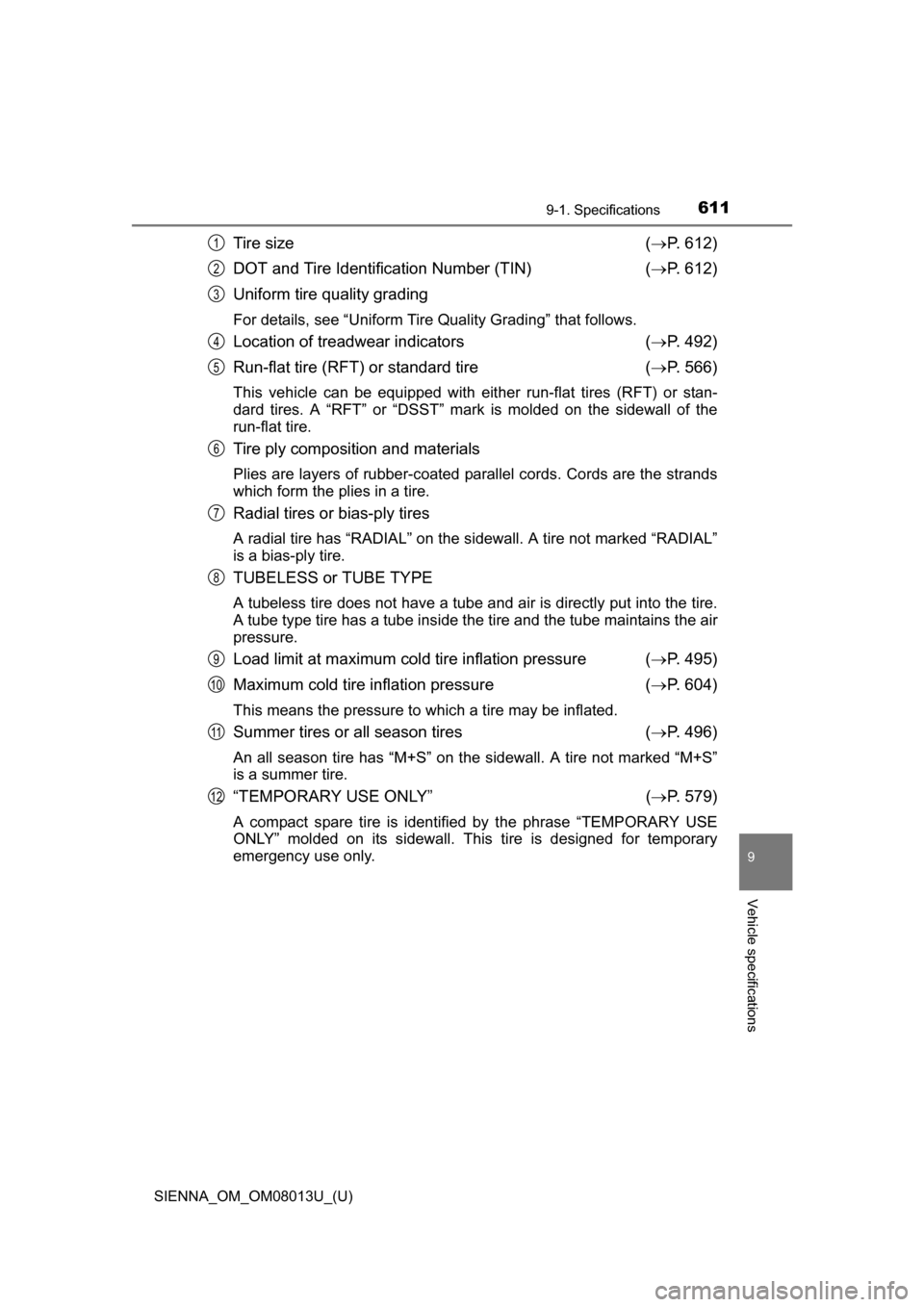
SIENNA_OM_OM08013U_(U)
6119-1. Specifications
9
Vehicle specifications
Tire size( P. 612)
DOT and Tire Identification Number (TIN) ( P. 612)
Uniform tire quality grading
For details, see “Uniform Tire Quality Grading” that follows.
Location of treadwear indicators ( P. 492)
Run-flat tire (RFT) or standard tire ( P. 566)
This vehicle can be equipped with ei ther run-flat tires (RFT) or stan-
dard tires. A “RFT” or “DSST” mark is molded on the sidewall of the
run-flat tire.
Tire ply composition and materials
Plies are layers of rubber-coated parallel cords. Cords are the strands
which form the plies in a tire.
Radial tires or bias-ply tires
A radial tire has “RADIAL” on the sidewall. A tire not marked “RADIAL”
is a bias-ply tire.
TUBELESS or TUBE TYPE
A tubeless tire does not have a tube and air is directly put into the tire.
A tube type tire has a tube inside the tire and the tube maintains the air
pressure.
Load limit at maximum cold tire inflation pressure ( P. 495)
Maximum cold tire inflation pressure ( P. 604)
This means the pressure to which a tire may be inflated.
Summer tires or all season tires ( P. 496)
An all season tire has “M+S” on the sidewall. A tire not marked “M+S”
is a summer tire.
“TEMPORARY USE ONLY” ( P. 579)
A compact spare tire is identified by the phrase “TEMPORARY USE
ONLY” molded on its sidewall. This tire is designed for temporary
emergency use only.
1
2
3
4
5
6
7
8
9
10
11
12
Page 612 of 668
612
SIENNA_OM_OM08013U_(U)
9-1. Specifications
DOT symbol*
Tire Identification Number (TIN)
Tire manufacturer’s identifica-
tion mark
Tire size code
Manufacturer’s optional tire
type code (3 or 4 letters)
Manufacturing week
Manufacturing year
*: The DOT symbol certifies that the tire conforms to applicable Federal
Motor Vehicle Safety Standards.
■Typical tire size information
The illustration indicates typical tire size.
Typical DOT and Tire Identification Number (TIN)
1
2
3
4
5
6
Tire size
7
Tire use
(P = Passenger car,
T = Temporary use)
Section width (millimeters)
Aspect ratio
(tire height to section width)
Tire construction code
(R = Radial, D = Diagonal)
Wheel diameter (inches)
Load index (2 digits or 3 dig-
its)
Speed symbol
(alphabet with one letter)
Run-flat tire code1
2
3
4
5
6
7
8
Page 615 of 668
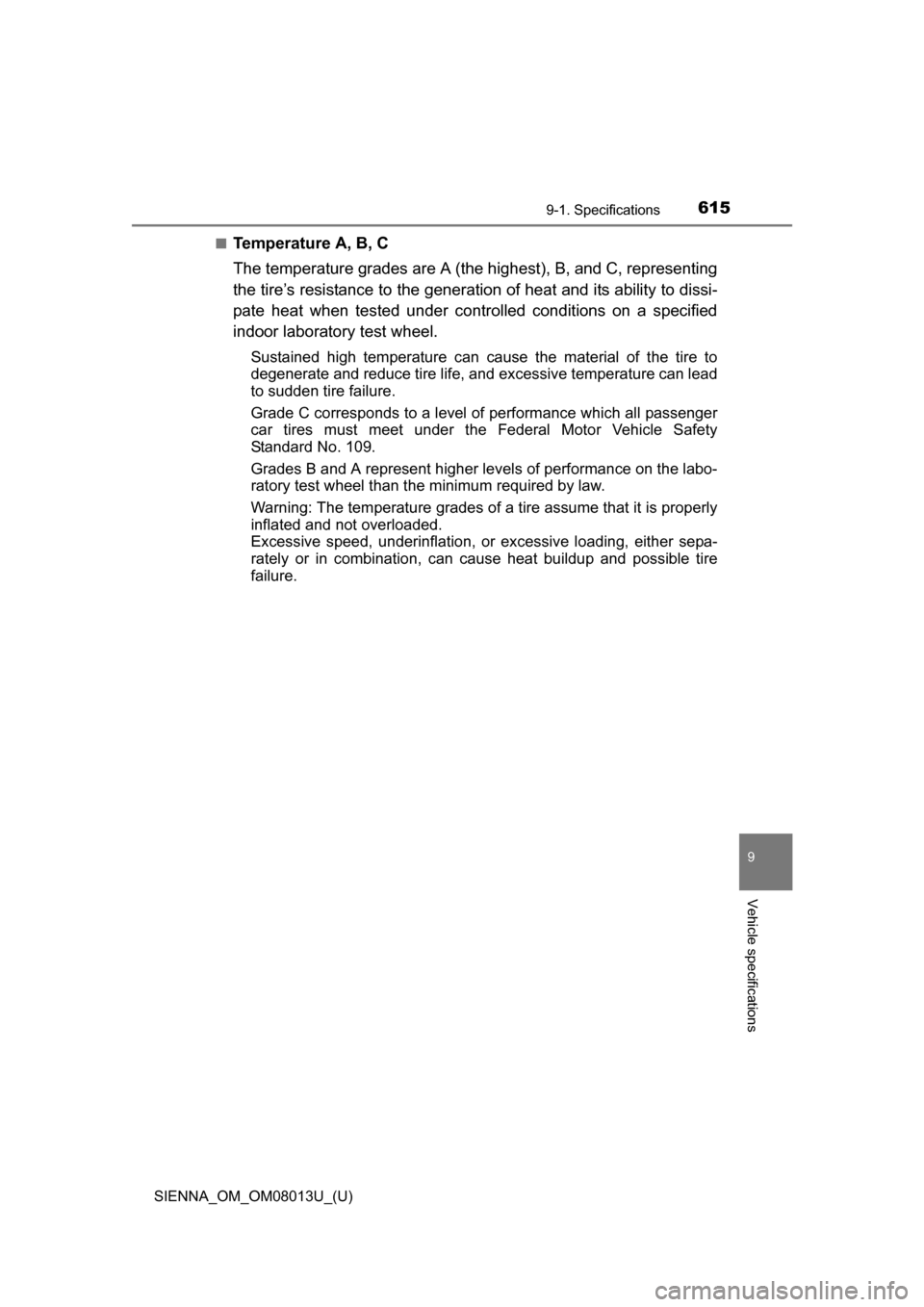
SIENNA_OM_OM08013U_(U)
6159-1. Specifications
9
Vehicle specifications
■Temperature A, B, C
The temperature grades are A (the highest), B, and C, representing
the tire’s resistance to the generation of heat and its ability to dissi-
pate heat when tested under cont rolled conditions on a specified
indoor laboratory test wheel.
Sustained high temperature can cause the material of the tire to
degenerate and reduce tire life, and excessive temperature can lead
to sudden tire failure.
Grade C corresponds to a level of performance which all passenger
car tires must meet under the Federal Motor Vehicle Safety
Standard No. 109.
Grades B and A represent higher le vels of performance on the labo-
ratory test wheel than the minimum required by law.
Warning: The temperature grades of a tire assume that it is properly
inflated and not overloaded.
Excessive speed, underinflation, or excessive loading, either sepa-
rately or in combination, can cause heat buildup and possible tire
failure.
Page 616 of 668
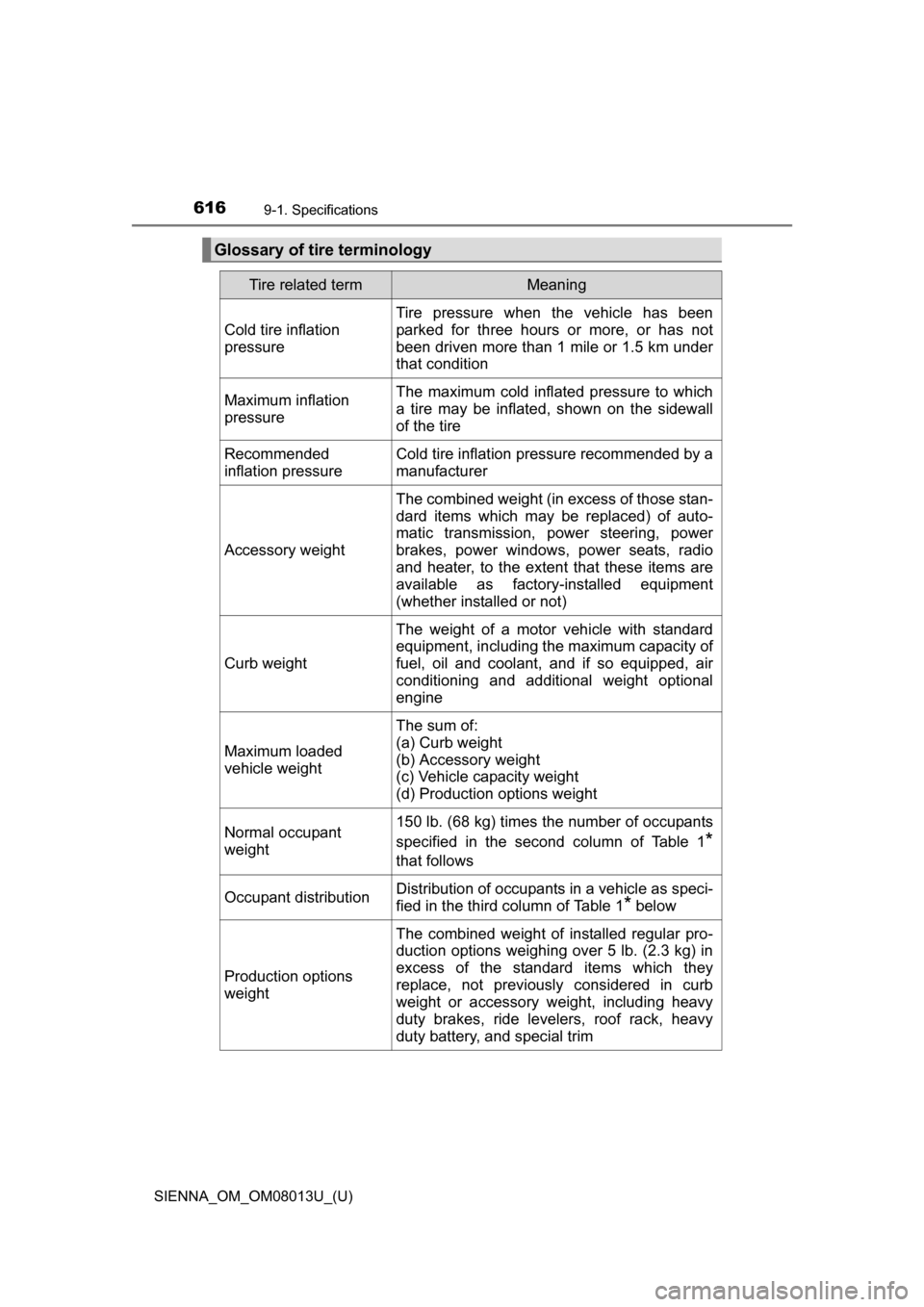
616
SIENNA_OM_OM08013U_(U)
9-1. Specifications
Glossary of tire terminology
Tire related termMeaning
Cold tire inflation
pressure Tire pressure when the vehicle has been
parked for three hours or more, or has not
been driven more than 1 mile or 1.5 km under
that condition
Maximum inflation
pressure The maximum cold inflat
ed pressure to which
a tire may be inflated, shown on the sidewall
of the tire
Recommended
inflation pressure Cold tire inflation pressure recommended by a
manufacturer
Accessory weight The combined weight (in excess of those stan-
dard items which may be replaced) of auto-
matic transmission, power steering, power
brakes, power windows, power seats, radio
and heater, to the extent
that these items are
available as factory-installed equipment
(whether installed or not)
Curb weight The weight of a motor vehicle with standard
equipment, including the maximum capacity of
fuel, oil and coolant, and if so equipped, air
conditioning and additional weight optional
engine
Maximum loaded
vehicle weight The sum of:
(a) Curb weight
(b) Accessory weight
(c) Vehicle capacity weight
(d) Production options weight
Normal occupant
weight 150 lb. (68 kg) times the number of occupants
specified in the second column of Table 1
*
that follows
Occupant distribution Distribution of occupants in a vehicle as speci-
fied in the third column of Table 1
* below
Production options
weight The combined weight of installed regular pro-
duction options weighing over 5 lb. (2.3 kg) in
excess of the standard items which they
replace, not previously considered in curb
weight or accessory weight, including heavy
duty brakes, ride levelers, roof rack, heavy
duty battery, and special trim
Page 617 of 668
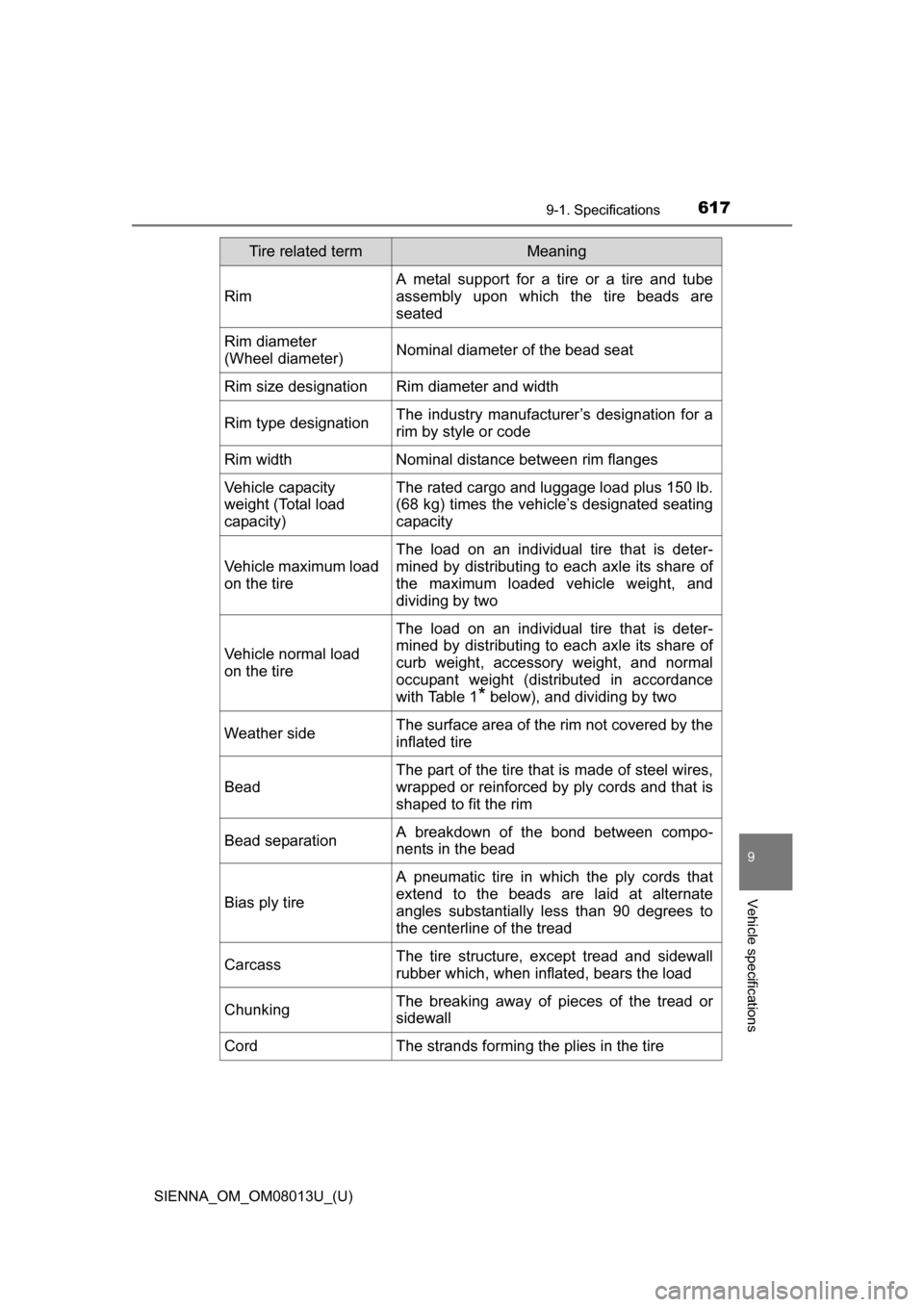
SIENNA_OM_OM08013U_(U)
6179-1. Specifications
9
Vehicle specifications
RimA metal support for a tire or a tire and tube
assembly upon which the tire beads are
seated
Rim diameter
(Wheel diameter) Nominal diameter of the bead seat
Rim size designation Rim diameter and width
Rim type designation The industry manufacturer’s designation for a
rim by style or code
Rim width Nominal distance between rim flanges
Vehicle capacity
weight (Total load
capacity) The rated cargo and luggage load plus 150 lb.
(68 kg) times the vehicle’s designated seating
capacity
Vehicle maximum load
on the tire The load on an individual tire that is deter-
mined by distributing to each axle its share of
the maximum loaded vehicle weight, and
dividing by two
Vehicle normal load
on the tire The load on an individual tire that is deter-
mined by distributing to each axle its share of
curb weight, accessory weight, and normal
occupant weight (distributed in accordance
with Table 1
* below), and dividing by two
Weather side The surface area of the rim not covered by the
inflated tire
Bead The part of the tire that is made of steel wires,
wrapped or reinforced by ply cords and that is
shaped to fit the rim
Bead separation A breakdown of the bond between compo-
nents in the bead
Bias ply tire A pneumatic tire in which the ply cords that
extend to the beads are laid at alternate
angles substantially less than 90 degrees to
the centerline of the tread
Carcass The tire structure, except tread and sidewall
rubber which, when inflated, bears the load
Chunking The breaking away of pieces of the tread or
sidewall
Cord The strands forming the plies in the tire
Tire related termMeaning